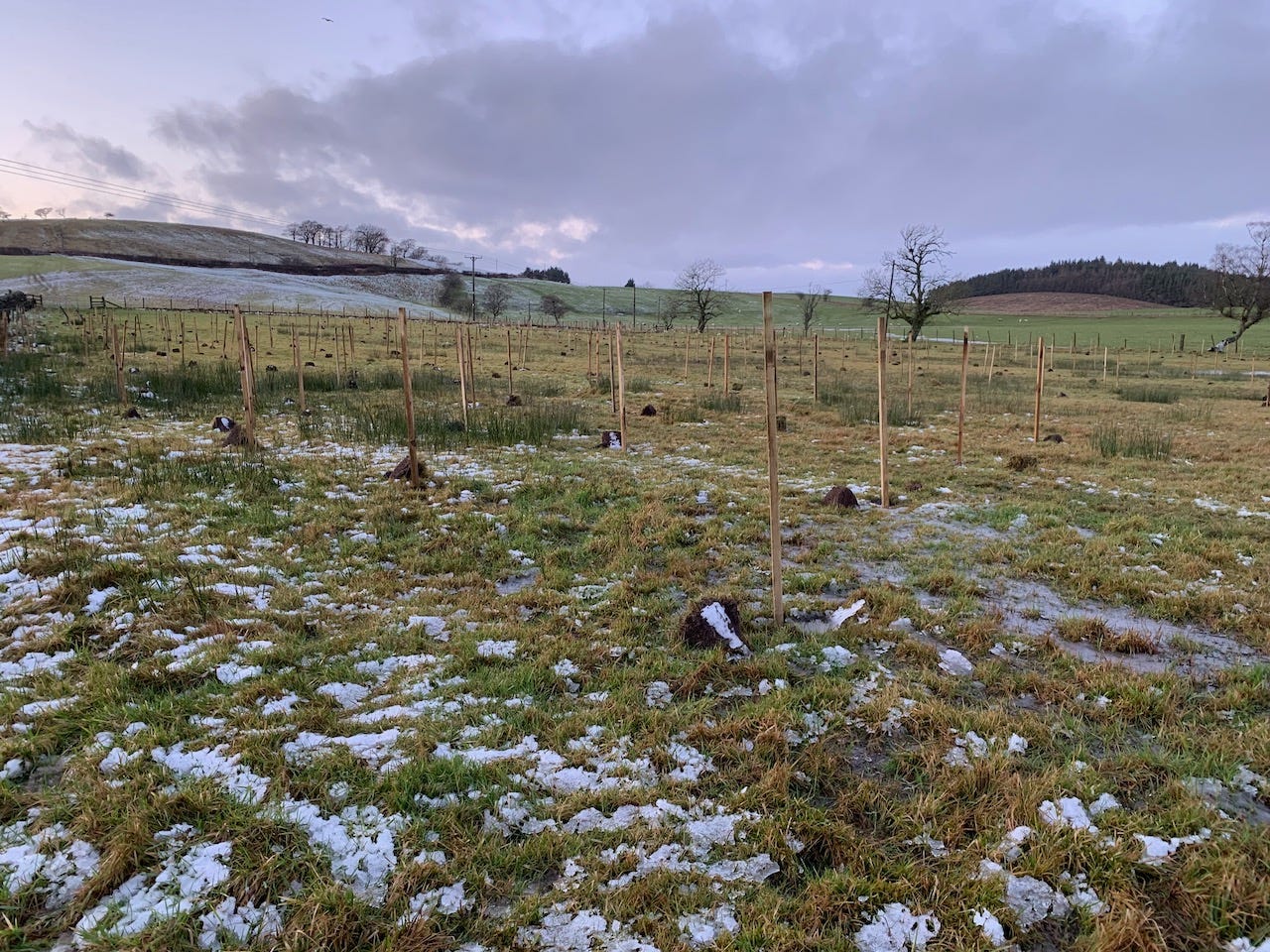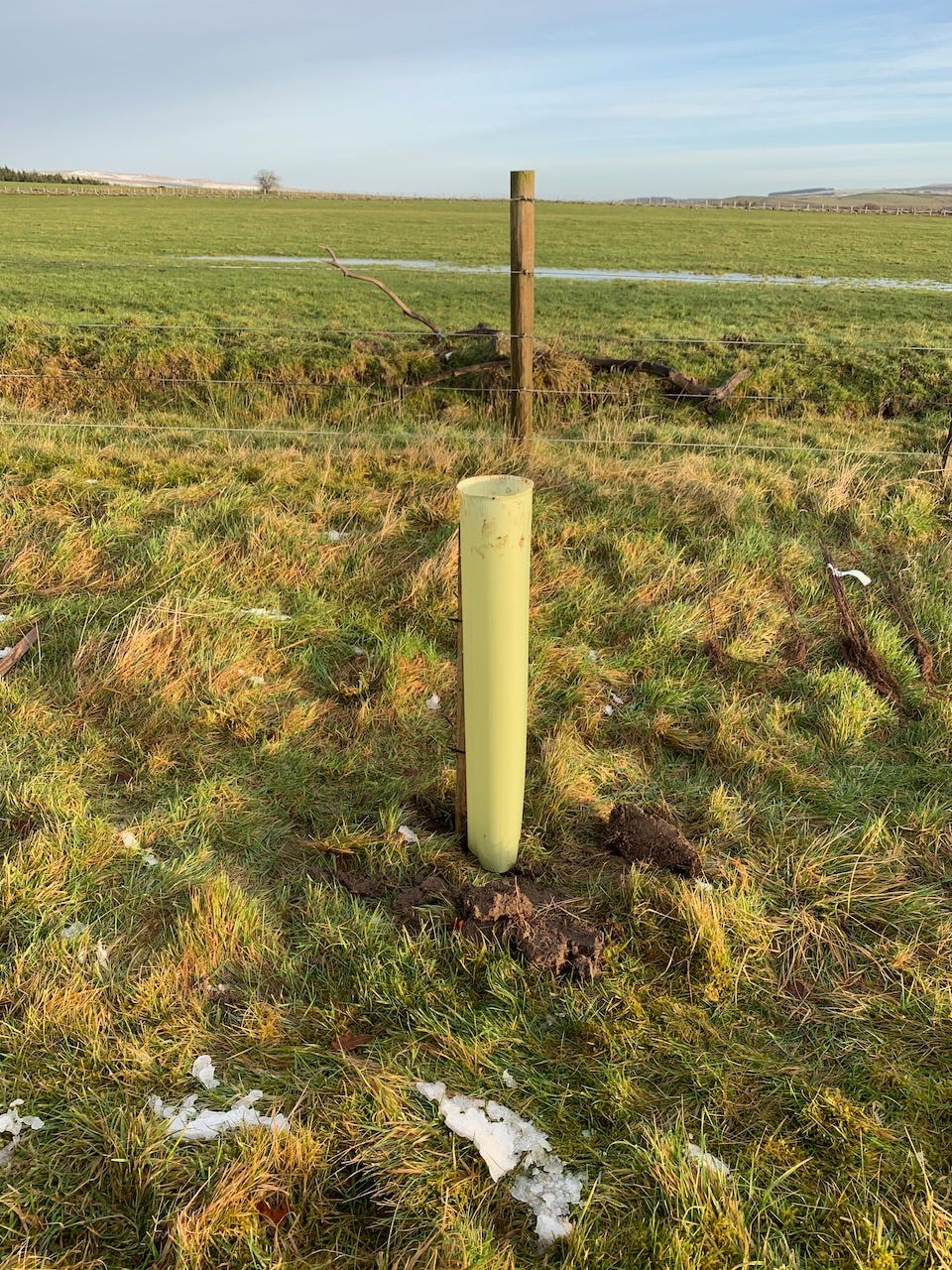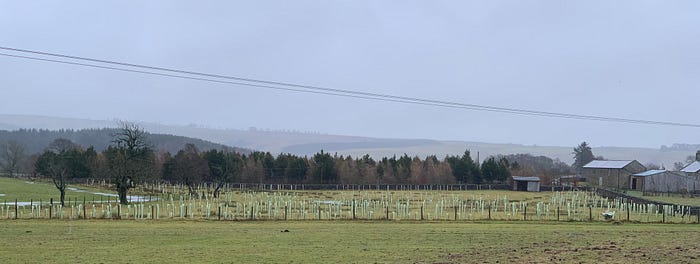Establishing a New Woodland. Part 3: Planting
This is not an article about the technology, product or business topics I usually write about. It is the story of planting a new 0.75 Hectare (1.8 Acres) woodland. There are undoubtedly some lessons for CTOs, Product Managers and Startup owners in here somewhere but I’m not going to attempt to find them; I’ll leave that up to you if you’re so motivated!
This is Part 3 of a short series. Part 1 describes the planning process and Part 2 the site preparation.
Of all the deliveries we’ve had over the pandemic period I can safely say nothing has been as eagerly anticipated as the pallet of trees, tree stakes and protectors that arrived on January 15th 2021. I was expecting to be a little underwhelmed by the trees; they’re just “whips” in the local parlance (young saplings ranging from 40–100cm tall) but I was also slightly taken aback by the amount of plastic tubing and tree stakes.


Up bright and early on the 16th and …


Okay, so not the Beast from the East but not exactly ideal tree planting conditions either. During winter — as I understand it — trees go into a state of hibernation as their sap stops flowing. All their energy is stored in their roots so you can, and should, plant trees while it’s cold. But you can’t plant them into frozen ground as the roots get damaged and the tree has no chance to get established.
Undeterred I decided that if I couldn’t plant trees I could at least plant tree stakes and so my wife and I spent the day sloshing about in the thawing snow banging tree stakes into semi-frozen ground.



Then, finally, on the 17th, we got to plant some trees!
And boy was it slow going …
I’d expected to be able to plant the trees in 3–4 days given that’s what it took to dig the holes but the first morning we only managed to plant 70 trees in 4 hours with two of us working. I was slightly panicked by this but after a bit of consideration over a warm drink, I realised that trying to plant row-by-row according to the plan was really slowing us down.
Firstly different tree species are really quite different. This may sound obvious but even whips of roughly the same size have quite varied characteristics. Willow are super slim and straight with small roots; Alder are quite bushy with medium-sized roots; Oak are a little less bushy but with bigger roots; and Crab Apples are right bastards: bushy, spiky and with huge roots that required the holes we had prepared to be enlarged.
Although the basic technique of siting the whip, packing the earth around it and dropping the protector over it and the stake is the same, each different species requires a slightly different approach and so by swapping species every 10 or 20 trees we were having to rethink and re-equip too often.
In the afternoon we switched tactics to planting just one species at a time. We were still planting to the plan but leaving gaps where other species were to go and then coming back to those gaps when we got to planting the species that were planned for them. Intuitively this seemed like it should be slower but we got 130 trees planted in the next three hours. 200 trees in a day was a bit less than I’d hoped but we’d figured things out like:
- Matching whips to holes: don’t just plant trees in the order they come out of the bag, grade them into small, medium and large specimens and then drop the smallest specimens in the smaller holes and the larger ones in the larger holes … admittedly not rocket science!
- Matching protectors to species: the protectors come in groups of five stacked inside each other. So the innermost protector is less than half the diameter of the outermost. Again, instead of dropping protectors over trees in the order you plant them we used the thinnest ones for the species like Willow and Rowan and the largest ones for the Oaks and the damn Crab Apple.
- Splitting the plugs before starting to plant. I should have thought of this when we were digging the holes in the first place. At the start we were pulling the plugs apart by hand and wrapping them around the roots of the whips. This was time consuming and tiring so I started splitting them with a spade and it was much quicker to split 25 or 50 plugs at a time. Of course, for the new holes I dug I now knew to split the plug as I dug it out; much quicker still.







By lunchtime on the 18th we’d got about 400 trees in.

But with temperatures dropping and more snow forecast we decided to ‘heel in’ the remaining trees. This just requires a shallow trench to be dug and the roots of the bundles of trees to be covered in loose soil. Not planted, just packed enough to protect the roots from frost and critters. You can do this in the field you’re planting in but we just popped ours into a couple of patches in the vegetable garden.

For the next ten days the temperature was dropping to between -3 and -7 Celcius overnight and planting just wasn’t on the cards. But then, for the last week, the temperature has been hovering between 1 and 4 Celcius which is perfectly decent for planting.
And so, between last weekend when we planted another 300 trees, a few breaks between online video calls for work during the week to get the odd batch of 25 trees in, and this weekend, we’re finished! About three weeks later than expected but with a total planting time of ~5 days.

Just what we dreamed of: a field of sticks and plastic! Unfortunately the protectors are completely necessary due to the number of deer and hare we have around the place. But imagine it in 15 years time …

The fourth part of this article deals with deals with lessons learned and how we might do things different next time. Establishing a New Woodland. Part 4: Reflections.
